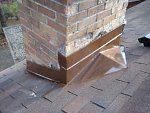What Causes a Leaky Chimney
Author: steve Published Under: Home

Having a leak around your chimney can ultimately cost a great deal of money and is often not discovered until a significant amount of damage has already been done. In most cases, the leak is caused by improper flashing around the chimney, which is commonly seen when a home has received a new roof, but the flashing was not installed correctly.
On many homes with fireplaces, the chimney extends directly through the roof. Depending on the location of the fireplace, this may mean that all four sides of the chimney are surrounded by the roof, or there could be less as well.
What is Flashing?
Flashing is installed around the chimney, ensuring that water on the roof is not able to leak into the area between the brick fireplace and the roof shingles Not only does the flashing help prevent leaks caused by spaces in between the shingles and chimney, but it also helps to account for the subtle changes that will occur in the brick and mortar as it ages.
Flashing actually includes a few components, with a bottom layer of flashing, called the base flashing, first being installed on the front of the chimney and wrapped around it. Next, step flashing is connected to the roof and bent to go up the sides of the chimney.
A cricket is installed on the side of the chimney that faces the peak of the roof. The cricket is triangular shaped and is designed to push water around the chimney. The cricket has the same slope as the roof does and allows water to flow around the chimney, rather than collecting at its base. In cases where a large cricket is installed, it is common to cover them with shingles, so that it blends in better with the home.
Finally, cap flashing is installed onto the chimney and folded down onto the roof. The cap flashing overlaps the seams of the other flashing, preventing water from seeping in between the seams.
Leaky Flashing
Most often, the cause of a leak around a chimney is improperly installed flashing. In cases where the roof has been removed, it is not uncommon to find that the cap flashing, which extends from the chimney over the seams of the other flashing, has been replaced with roof tar. This is because it is easier to install and costs less, but the roof tar or asphalt cement will not be a permanent solution and eventually water will find its way through it.
It is also common for the cricket to be left out, which is designed to help direct water around either side of the chimney, as it flows off the roof. Many times, builders will not install a cricket, which will almost always lead to roof leaks later down the road.